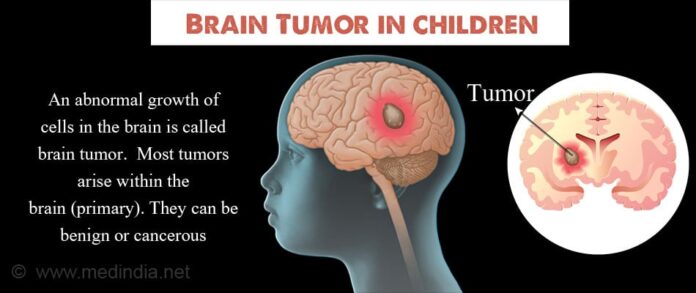Brain tumors in children
The most frequent type of tumor to form in youngsters is a brain tumor. Children of all ages could be impacted. A little more often in boys than in girls.
More kids than ever before are surviving pediatric cancer. In addition to working to lessen the consequences of previous cancers, we now have access to new and improved medications and treatments.
Receiving the news that your child has cancer is traumatic. Although it can feel overwhelming at times, there are lots of support groups and medical specialists available to assist you get through this trying period.
Parents might frequently find it easier to cope if they have greater knowledge about the cancer their kid has and the potential treatments. More specific information will be provided by your child’s expert, and it’s vital to ask any questions you may have of the medical professional who specializes in treating your child’s particular condition.
Why customised medicine can benefit from India’s first comprehensive healthy microbiome map
Brain Tumors
A brain tumor may originate from another area of the body (secondary) or from the brain itself (primary). This article discusses primary brain tumors.
Signs and symptoms
The location, size, and impact of the tumor on the affected brain region will all affect the symptoms. The pressure inside the skull is higher than it should be, which results in symptoms. A developing tumor may push aside healthy brain tissue or obstruct the brain’s fluid flow. This is referred to by doctors as elevated intracranial pressure, and it can result in symptoms like:
- headaches, which are usually worse in the morning
- feeling nauseous or vomiting, usually in the morning
- seizures, or fits
- feeling extremely agitated or lacking interest in routine activities
- irregular eye movements, double or blurry vision, and an extreme fatigue that sets in much faster than typical
- feeling excessively groggy or sleepy without cause
Additionally, movement difficulties, weakness on one side of the body, and behavioral abnormalities can all be brought on by brain tumors. In the early stages, this might be confusing because some of these symptoms are typical even in the absence of a brain tumor.
The brain
The skull, which houses the brain, serves as its protective shell. The meninges are three layers of membrane that lie between the brain and the skull. They serve to shield and fully encase the brain and spinal cord. There is a space between two of these layers where cerebrospinal fluid (CSF), which surrounds the brain and spinal cord, is found.
The brain’s primary regions are:
- The main portion of the brain, the cerebrum, is located at the top of the skull and is divided into two parts, or hemispheres. It regulates thinking, memory, problem-solving, emotions, touch, and thinking as well as helping us be aware of our physical location.
- The cerebellum, which is located near the rear of the brain and regulates balance, coordination, and movement
- The brain stem, located in the lower brain slightly above the back of the neck, is responsible for controlling respiration, body temperature, heart rate, blood pressure, eye movements, and swallowing. It also connects the brain to the spinal cord.
What takes place if there is a possible brain tumor
It can help to know what to expect from an exam. Don’t be scared to ask questions; the specialized doctor and nurse will be happy to clarify everything.
Your child will be thoroughly examined by your doctor, who will also want to know about any recent issues your child has experienced. This will involve using an ophthalmoscope to examine the backs of your child’s eyes for swelling, which may indicate elevated brain pressure. Other aspects including balance, coordination, feeling, and reflexes are typically examined as well.
CT or MRI Scan
The majority of kids will undergo an MRI or CT scan, which provides an up-close view of the brain.
X-rays are used in CT scans. Although it is rapid and frequently the best initial examination, an MRI provides more detailed images. Since it requires a significant amount of X-rays, we should take care to avoid using it on too many people.
An MRI scan takes far longer but produces more detailed images without the need for X-rays. Machines make noise, and kids frequently can’t stay still long enough to snap good pictures. Anesthesia may occasionally be required for this scan.
In most cases, standard X-rays are not useful for brain tumors.
Blood tests
In addition to being used to help diagnose certain tumor types, they are typically performed to ensure that a surgery is safe to perform.
An Autopsy
It’s often necessary for doctors to remove a small part of the tumour (biopsy) to find out exactly what type of tumour it is. It means your child will need to go into hospital for an operation under general anaesthetic. The piece of tumour removed is then examined under a microscope by a specialist doctor called a pathologist.
A biopsy isn’t always done; it is sometimes better to remove the whole tumour in one operation. In this case, it will be a few days before the exact type of tumour is known.
Sometimes, it may be safer to do the operation in two stages. Part of the tumour might be removed in the first operation and the rest a few days later.
Types of brain tumors
Brain tumors come in a variety of forms and are typically called after the cell type from which they originate. While there are numerous more, less common kinds, the three primary types are medulloblastoma, ependymoma, and astrocytoma.
Benign (non-cancerous) or malignant (cancerous) brain tumors are both possible.
Benign brain tumors
benign brain tumorsThey often don’t travel to other parts of the brain; instead, they stay in the original location. Because of its location, a benign tumor can occasionally be challenging to remove, necessitating the use of additional therapies.
A low-grade astrocytoma, commonly known as a low-grade glioma, is the most prevalent type of tumor of this kind.
Initial brain tumors that are Malignant
These are most likely to cause issues by applying pressure, inflicting damage to the surrounding tissue, and potentially even spreading to nearby normal brain tissue.
High-grade Ependymoma and Astrocytomas
These tumors, also known as gliomas, arise from the brain’s glial cells, which serve as its supporting tissue.
Medulloblastomas
These typically begin to form in the cerebellum, the lower region of the brain. Treatment needs to address the possibility of them spreading to other brain regions or the spinal cord.
Intervention
Each patient will have a varied course of treatment due to the variety of brain tumor forms. Before choosing the best course of action, the experts will examine the type, size, and location of the brain tumor.
These are the principal therapies for brain tumors. One treatment or a mix of treatments may be administered to your child.
Continuation of care
After treatment is over, your child will be seen regularly by specialists. This is to check their progress and how well they’re recovering from treatment. It is also to check that they don’t have any long-term problems from treatment.
You can contact your child’s specialist doctor or nurse at any time if you have any worries about their health.




























